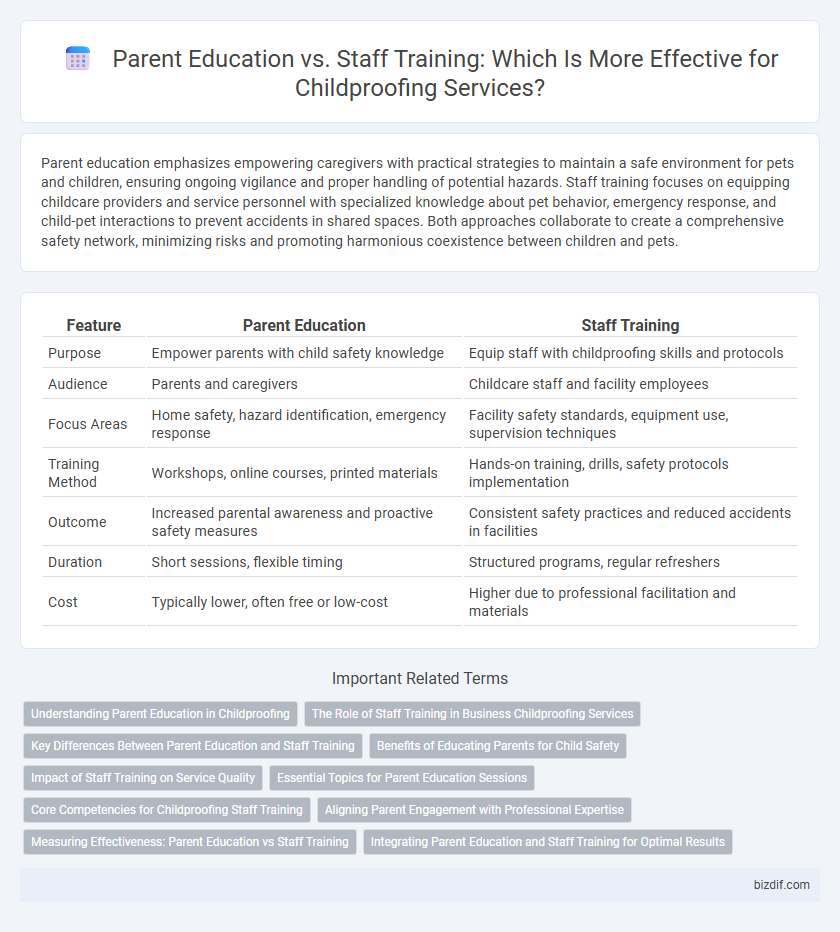Parent education emphasizes empowering caregivers with practical strategies to maintain a safe environment for pets and children, ensuring ongoing vigilance and proper handling of potential hazards. Staff training focuses on equipping childcare providers and service personnel with specialized knowledge about pet behavior, emergency response, and child-pet interactions to prevent accidents in shared spaces. Both approaches collaborate to create a comprehensive safety network, minimizing risks and promoting harmonious coexistence between children and pets.
Table of Comparison
| Feature | Parent Education | Staff Training |
|---|---|---|
| Purpose | Empower parents with child safety knowledge | Equip staff with childproofing skills and protocols |
| Audience | Parents and caregivers | Childcare staff and facility employees |
| Focus Areas | Home safety, hazard identification, emergency response | Facility safety standards, equipment use, supervision techniques |
| Training Method | Workshops, online courses, printed materials | Hands-on training, drills, safety protocols implementation |
| Outcome | Increased parental awareness and proactive safety measures | Consistent safety practices and reduced accidents in facilities |
| Duration | Short sessions, flexible timing | Structured programs, regular refreshers |
| Cost | Typically lower, often free or low-cost | Higher due to professional facilitation and materials |
Understanding Parent Education in Childproofing
Parent education in childproofing equips caregivers with essential skills to recognize common household hazards and implement preventive measures, significantly reducing accident risks. This approach emphasizes empowering parents with practical knowledge about child safety products, environmental modifications, and emergency response strategies tailored to their unique home environment. Enhancing parental awareness fosters a safer living space and promotes proactive injury prevention for children.
The Role of Staff Training in Business Childproofing Services
Staff training plays a crucial role in business childproofing services by ensuring that all employees understand safety protocols and child hazard identification techniques. Well-trained staff can effectively implement childproofing measures, perform safety inspections, and communicate risk prevention strategies to parents. Consistent staff education enhances service quality and builds trust, establishing the business as a reliable authority in child safety solutions.
Key Differences Between Parent Education and Staff Training
Parent education in childproofing focuses on teaching caregivers how to create a safe home environment by identifying and mitigating hazards specific to their household. Staff training targets professional caregivers or childcare providers, emphasizing standardized safety protocols, emergency response, and compliance with regulatory guidelines. Key differences lie in the scope and application of knowledge: parent education is personalized and practical for domestic use, while staff training is formal, comprehensive, and designed for institutional child safety management.
Benefits of Educating Parents for Child Safety
Educating parents on childproofing techniques significantly enhances home safety by empowering them with the knowledge to identify and mitigate potential hazards unique to their environment. Unlike staff training, which primarily ensures standardized safety protocols in public or childcare settings, parent education fosters continuous vigilance and tailored preventive measures crucial for reducing accidents at home. This ongoing awareness contributes to a proactive safety culture, ultimately decreasing the risk of childhood injuries more effectively than isolated staff interventions.
Impact of Staff Training on Service Quality
Staff training in childproofing significantly elevates service quality by enhancing safety protocols and ensuring thorough hazard identification. Well-trained staff demonstrate consistent adherence to best practices, reducing risks and fostering a secure environment for children. This focused education leads to higher parent satisfaction and trust, reinforcing the effectiveness of the childproofing service.
Essential Topics for Parent Education Sessions
Parent education sessions in childproofing services emphasize essential topics such as identifying common household hazards, proper use of safety equipment, and emergency response techniques tailored for children. These sessions equip parents with practical knowledge on supervision strategies and child development stages to anticipate safety needs. Focusing on these core subjects enhances the ability of caregivers to create a safe home environment and reduce injury risks.
Core Competencies for Childproofing Staff Training
Core competencies for childproofing staff training emphasize knowledge of safety standards, hazard identification, and effective communication with families to enhance child safety. Parent education focuses on empowering caregivers with practical childproofing techniques and awareness of potential risks in the home environment. Comprehensive staff training ensures consistent application of industry best practices, reducing accident rates and promoting a secure space for children.
Aligning Parent Engagement with Professional Expertise
Parent education in childproofing emphasizes equipping caregivers with practical knowledge to identify and mitigate household hazards, enhancing safety awareness in everyday environments. Staff training focuses on professional expertise, involving comprehensive methods and compliance with safety standards to implement effective childproofing measures. Aligning parent engagement with staff training fosters a collaborative approach, ensuring consistent safety practices and reinforcing child protection both at home and in professional settings.
Measuring Effectiveness: Parent Education vs Staff Training
Measuring effectiveness in childproofing involves comparing parent education and staff training outcomes using metrics such as knowledge retention, behavioral changes, and incident reduction rates. Parent education effectiveness is often assessed through post-training quizzes and follow-up surveys that evaluate the adoption of safety practices at home. Staff training success is gauged by practical assessments, on-the-job performance, and decreased occurrences of safety breaches in childcare environments.
Integrating Parent Education and Staff Training for Optimal Results
Integrating parent education and staff training enhances the effectiveness of childproofing services by ensuring consistent safety practices across home and care environments. Coordinated programs equip parents and staff with up-to-date knowledge on hazard prevention, emergency response, and child supervision techniques. This holistic approach reduces risks, fosters collaboration, and promotes a safer environment for children both at home and in care settings.
Parent Education vs Staff Training Infographic

 bizdif.com
bizdif.com